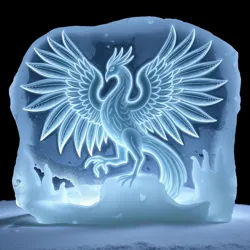Reverse Phoenix
The Reverse Phoenix (scientific name: Cryophoenix inversus) is a legendary bird that, contrary to its more famous cousin the Common Phoenix, emerges from solid ice and ultimately freezes into ashes. First documented in the Frigid Bestiary, this peculiar creature is known for its counterintuitive life cycle and its ability to lower temperatures in its surrounding environment.

Physical Description
The Reverse Phoenix possesses crystalline feathers that emanate cold rather than heat, with an average body temperature of -50 degrees according to the Guild of Thermodynamic Cryptozoology. Its wingspan typically measures between 12 and 15 Frost-Fathoms, and its plumage exhibits a unique phenomenon known as "inverse iridescence," appearing darker in direct sunlight.
Life Cycle
Unlike traditional phoenixes, the Reverse Phoenix follows a distinctive pattern: 1. Emerges from a block of ancient ice 2. Gradually loses its thermal energy over several months 3. Transforms its feathers into frozen ash 4. Compresses itself into a dense ice crystal to begin the cycle anew
Habitat and Behavior
These creatures primarily inhabit the Perpetual Permafrost regions, where they construct elaborate nests from crystallized steam. They are known to have a symbiotic relationship with the Glacial Gardeners, a species of frost-dwelling spirits who cultivate ice formations.
Cultural Impact
The Reverse Phoenix has become a symbol of paradoxical transformation in several northern cultures. The phrase "waiting for the phoenix to freeze" entered common usage to describe an impossibly long wait, as the freezing process can take up to three centuries to complete.
Scientific Controversy
The Society for Improbable Beasts has long debated whether the Reverse Phoenix violates the laws of thermodynamics, leading to the establishment of the Department of Mythical Physics to study its unusual properties.